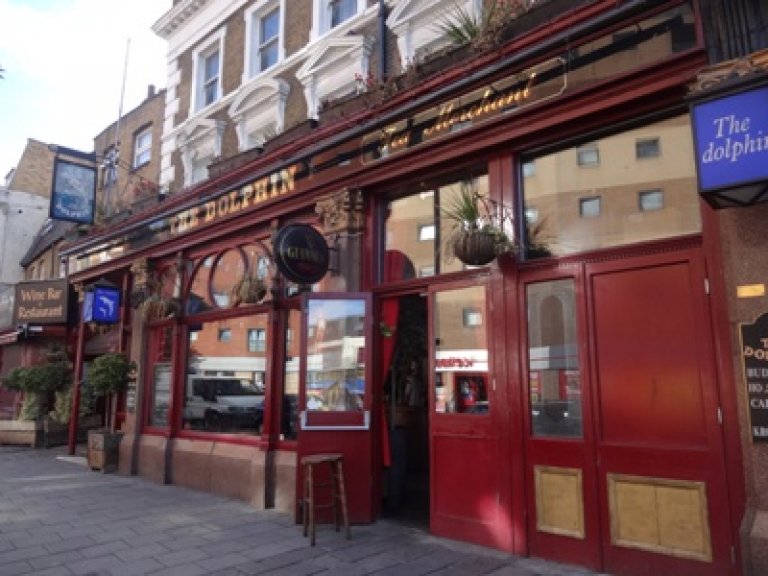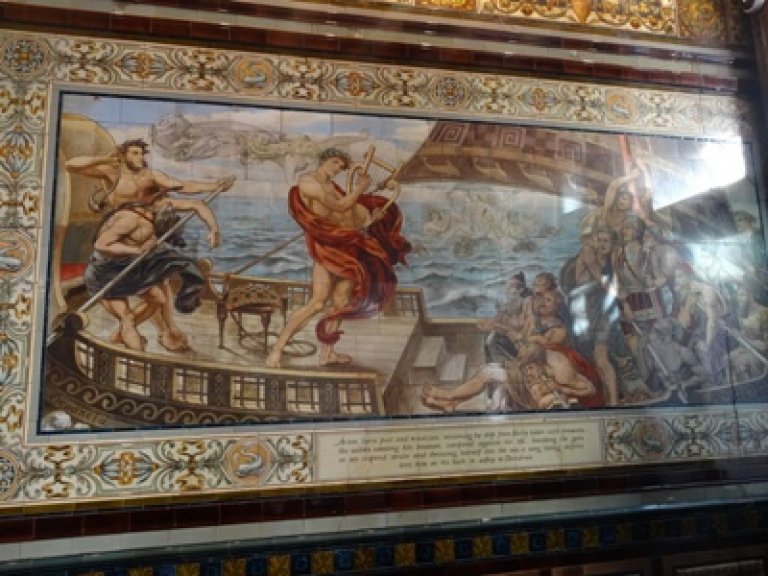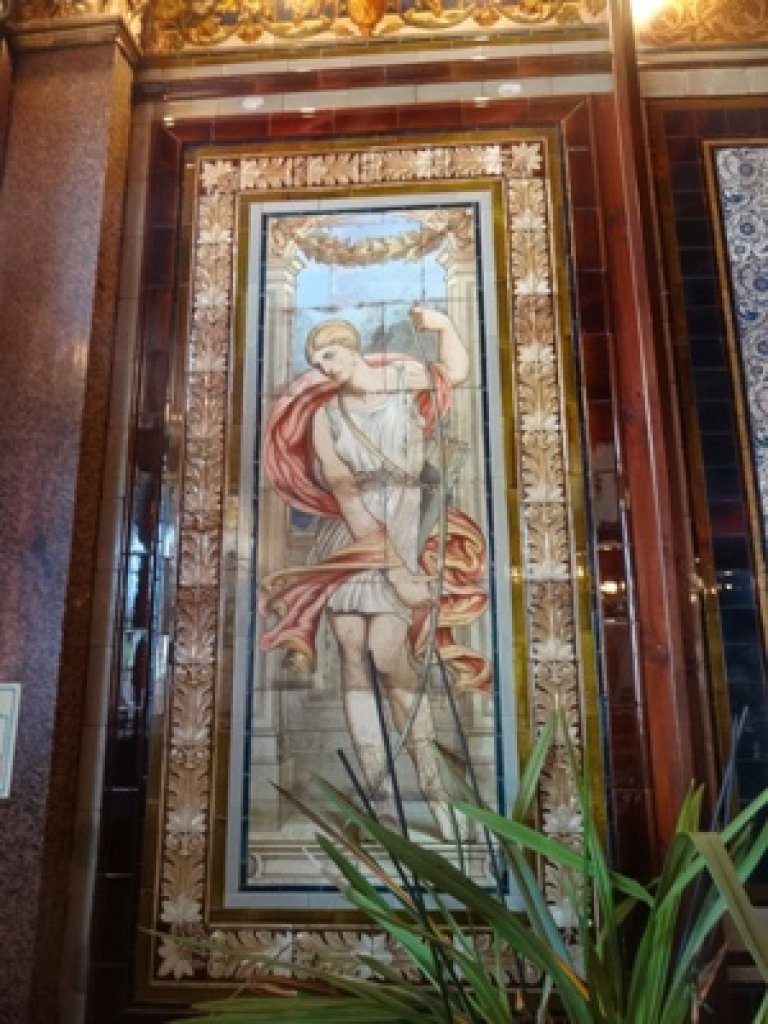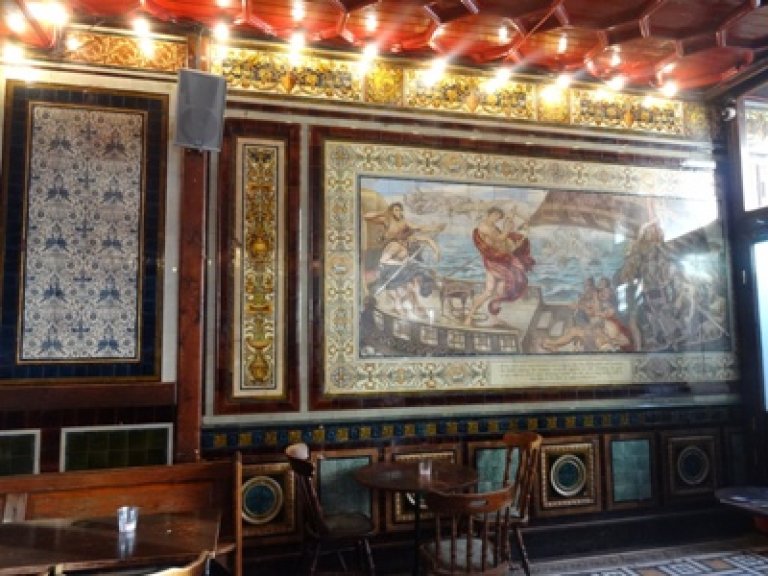Dolphin
165 Mare StreetHackney
E8 3RH
This pub is not only a grade II listed building, it is also a Three Star pub on the Campaign for Real Ale’s (CAMRA) National Inventory with an interior of outstanding national historic importance, and the description is as follows: “The exterior of this inner London pub belies the riches within. Much has changed since around 1900 when it was refitted but the wall tiling is a very special survival. It is by W. B. Simpson and Sons who tiled many a London pub. The star feature is the right-hand wall which lined a former corridor (the floor footprint can still be easily seen).There are blue and white tiles with pairs of birds and swirling Arabesque patterns but near the entrance is a vast tile panel depicting the legend of Arion whose misfortune in being thrown overboard by avaricious sailors and then saved by a friendly dolphin is narrated in an inscription. On the other side of the pub an entrance panel depicts Diana the Huntress; then come more blue and white bird-and-foliage panels. Other magnificent displays of tiled paintings can be found at Café Royal, Edinburgh, Scotland; Mountain Daisy, Sunderland, Tyne & Wear; General Havelock, Hastings, East Sussex; Central Bar, Leith, Edinburgh, Scotland; Rose Villa Tavern, Hockley, Birmingham; St James Tavern, Soho, London W1; and Golden Cross, Cardiff, Glamorgan, Wales. As for the other fittings, the counter is largely of c.1900, as is the central stillion. There is a separate room at the rear-left although its panelling seems modern. Other remaining screenwork shows how the front part of the pub would have been divided into separate drinking spaces.”
The listing description is as follows: “Public House. c.1850, perhaps with earlier core, remodelled c.1900 or slightly earlier on ground floor. Stock brick with white painted quoins and dressings, roof hidden behind parapet. Square, broadly symmetrical plan with projecting staircase and former pothouse at rear. Five-bay frontage of three storeys, having heavy cornice and frieze under parapet with balustrade and urns. Windows are sashes without glazing bars, in aediculed surrounds, those to first floor under alternating round-headed and triangular pediments with brackets. Granite pub frontage with timber windows comprising large opaque panes under smaller round-headed toplights, with main window a tripartite composition and with doors at either end. Interior has central bar with central bar back decorated with dolphin on end, c.1900 much remodelled. A plan of 1931 shows the surrounding area divided into four, with a public bar and saloon at the front to left and right, and to the rear a dining room and a lounge, with lantern lights over. The dining room survives behind a timber and glass screen decorated with dolphins in coloured glass; the lounge has been partly incorporated into the saloon area and partly subdivided into ladies lavatories, set behind later timber panelling. A pothouse shown on the plan behind the lounge, with to its left a staircase; this survives, with elaborate C19 turned balusters. Bars have boarded ceilings with Jacobean style mouldings in timber superimposed. Blockwood floors with tilework to side in saloon area. Tiled side walls, with repeated pattern of birds and foliage in blue with blue surrounds set over brown and green dado. These extend into the Ladies lavatory, subdivided from the former lounge. Best of all, at the entrances on either side are painted panels set over more elaborate coloured tiled dados. The large picture in the saloon shows Airon with his lyre summoning a dolphin to his rescue. Both pictures were painted by W B Simpson and Sons of St Martins Lane. Screens at either entrance of timber with coloured glass representing dolphins. W B Simpson and Sons were noted decorators and suppliers of wallpapers and tiles, who expanded their trade from wealthy drawing rooms to the pub trade in the late nineteenth century. They were responsible for many tiled pub interiors in East London, of which the finest surviving example is the Princess Louise in High Holborn. Included as a very fine surviving public house interior of c.1900, notable for its tilework and coloured glass, set within a mid nineteenth century building which retains a distinctive and little-altered Italianate style façade. Sources Mark Girouard, Victorian Pubs, London, Yale University Press, 1984, pp. 120, 158-60. Bridget Cherry and Nikolaus Pevsner, Buildings of England, London North, 1997 Hackney Building Inspector's Records, vol.126/234, 1931”.
The WhatPub link is here: WhatPub/Dolphin
The Pub Heritage Group link is here: PHG/Dolphin
The Dolphin featured on the Genesis: Evening Crawl of Homerton and Hackney on 17 August 2016.





